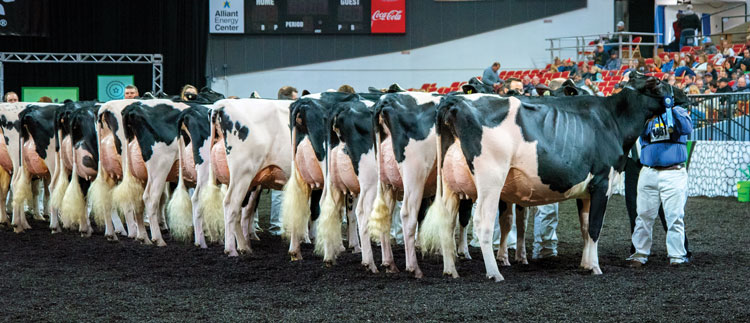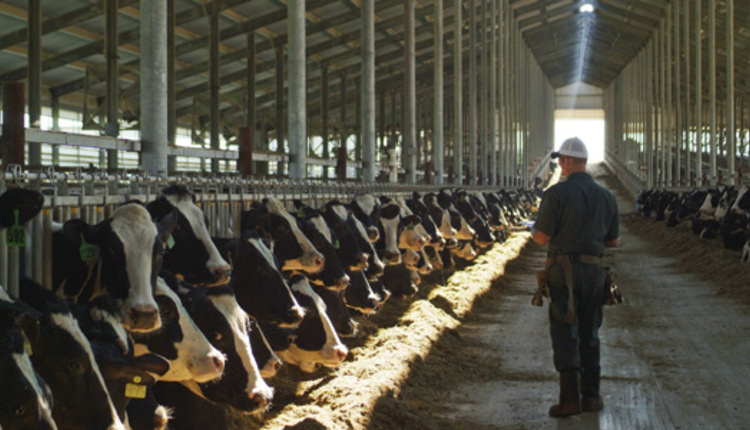The authors are with the University of Wisconsin-Madison School of Veterinary Medicine. They are most grateful to World Dairy Expo for supporting the 2017 and 2018 OBE study that was spearheaded by Mike Hellenbrand, Tom Morris, and Ernie Kueffner. They thank the Task Force of prominent breeders, exhibitors, judges, fitters, allied industry partners, and veterinarians that provided guidance, direction, and support and to the numerous volunteers who assisted them in data collection.

It is accepted that an udder filled with milk is advantageous to the exhibition of dairy cattle. While extending the time between milkings by more than 12 hours is the usual method for achieving the desired udder appearance, when ultrasound evaluation of udders emerged as a regular screening tool used at most major dairy cattle shows by the late 1990s, other unethical practices were detected. Ultrasound continues to be a valuable udder screening tool used at most shows and has also found a place in many veterinary practices today.
For almost 10 years, a trend toward overfilling udders for shows has been observed. Edema that is different, more severe, and easily distinguished from the udder edema that occurs in fresh cows has been detected by ultrasound. A recent study found that a 24-hour nonmilking interval in early and mid-lactation cows produced similar results and that the development of overbagging edema was associated with reduced eating time, a base-wide hind limb gait, and a rebound elevation in milk somatic cell count. Greater prevalence and severity of the condition at shows raised concerns for the health and well-being of exhibited cattle, negative public perception, and impact on the reputation of cattle shows.
World Dairy Expo addressed these concerns in 2017 by establishing a two-year task force of exhibitors, fitters, judges, classifiers, veterinarians, and other industry experts to tackle this complex problem. Some objectives of the overbagging task force were:
- Why does a cow with an udder full of milk develop edema?
- When does the udder edema associated with a prolonged milking interval become severe enough to be characterized as overbagging edema (OBE)?
- How much impact does the nonmilking interval have?
- Is there a breed or age of cow at higher risk of developing OBE?
- Does the external appearance of the udder change when OBE is present?
- Are there behavioral changes exhibited by cows with OBE?
- What is the prevalence of OBE since 2022?
- What factors associated with OBE can be controlled? Which cannot?
How does edema develop?
Udder edema is the accumulation of fluid in udder spaces outside of blood or lymphatic vessels. In late gestation and with the onset of lactation, a surge in blood flow supports udder growth. The expanding differential between the pressure in blood vessels and the tissue spaces in the udder pushes fluid out, causing edema.
In another situation, when an established milking interval is extended and milk accumulates in the udder, the resulting milk pressure may reduce blood flow to the udder while putting back pressure on veins, resulting in some leakage of fluid into tissue spaces. In more unusual circumstances, cattle may develop udder edema if blood protein concentration is low, varicose veins develop, or trauma, inflammation, or allergy raise blood vessel permeability.
Ultrasound is the gold standard for the diagnosis of udder edema. At dairy shows, five sites are examined: the right and left attachments on the fore udder and rear udder plus the rear udder seam. OBE of the fore udder is found midway up the side of the udder. Rear udder OBE is usually found midway up the rear udder, appearing first along the udder seam but moving outward toward the legs on both sides. OBE is characterized by severe edema in one or more locations or moderate edema found in two or more locations.
Cows are accustomed to 8- to 12-hour milking intervals, and a sudden increase in the interval can trigger the development of udder edema. OBE develops by 19 hours and is consistently noted when the nonmilking interval is longer than 24 hours. From the 2017 and 2018 World Dairy Expo data, the average reported nonmilking interval of cattle was 19 hours. Nonmilking intervals of more than 24 hours are rare but do occur.
The longer the nonmilking interval, the more likely OBE will develop. Fitters and exhibitors usually plan ahead for an ideal bagging time that matches the cow’s entry into the ring, but unexpected show delays, prolonged standing time, changes in appetite or abdominal fill, or the need to make repeated trips to the ring result in nonmilking intervals longer than anticipated.
What’s seen in the ring
Many believed that data acquired at the 2017 and 2018 World Dairy Expos would reveal a breed predilection for OBE. In both years, the Junior Holstein show had the highest prevalence of OBE. Among the seven breeds, Red and Whites tended to have a higher prevalence while Jerseys had a lower prevalence of OBE. Overall, severe OBE prevalence was less than 10%. Younger milking cows (yearlings in milk and junior and senior 2-year-olds) had the most OBE, while production cow classes in all breeds had the least OBE.
What has not been clearly established is whether ultrasound-detected OBE is associated with predictable udder appearance, gait, or behavior changes. When there are reliable external signs that OBE is present before a cow enters the ring, a decision to milk her out rather than show her can be made. Commitments like this are hard but ultimately ensure the health and welfare of our cows, positive public perception, and maintenance of a show’s reputation.
The loss of definition in the rear udder seam is due to edema and is usually the first sign of overbagging. In the absence of accompanying fore udder changes, ultrasound evidence of severe OBE is unlikely at this time.
What we have learned, however, is to pay close attention to the fore udder. When swelling is evident on both sides of the fore udder, OBE is much more likely to be moderate or severe. The fore udder changes predict that the cow will be walking with an exaggerated base-wide hind limb gait and tail swishing and exhibit an agitated demeanor. Alone, these individual behavior changes do not predict OBE, but together, they constitute a high risk that ultrasound will show moderate or severe OBE.
Interesting to us was the discovery that Jerseys exhibit more hind limb gait changes than any other breed, but they have a low prevalence of OBE. Cud chewing during the show was highest among Brown Swiss and Holsteins, two breeds with some of the lowest OBE prevalence. Having shared these findings from 2017 and 2018 with Expo judges in four out of eight shows, cows with the worst overbagging stood in the bottom half of the class, while half of the most severe overbagging edema stood in the top half of the class.
In conclusion, to prioritize cow welfare and health, OBE factors that can be controlled should be addressed. Minimizing hours of milk in the udder will reduce OBE. Observing fore udder appearance along with a triad of behavior changes described above prior to showing argue for milkout rather than showing. Implementing reliable cow show start times, class throughput, and frequent updates for exhibitors is essential. Empowering judges with the knowledge and support to make placings that discriminate against cows with OBE is also important.



